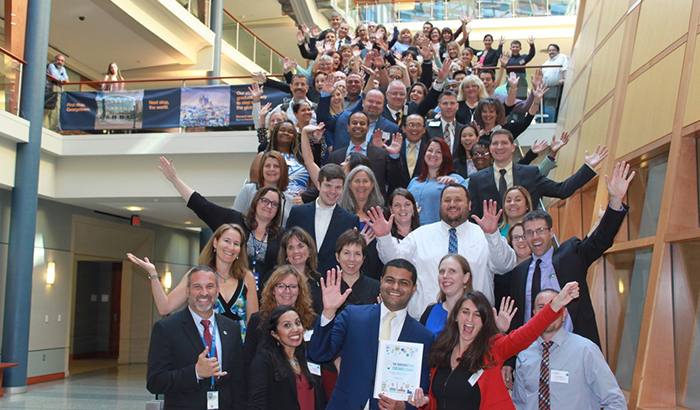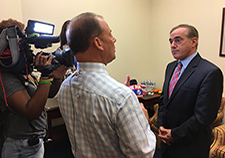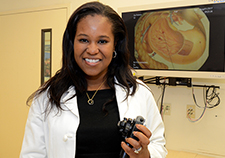Office of Research & Development |
 |


Andrea Ippolito, head of the VA Innovators Network (front center, in red jacket), and VA Assistant Deputy Under Secretary Shereef Alnahal (front center, in blue suit) join attendees of VA Innovation and Demo Day for a group photo. (VA photo)
August 17, 2017
By Mike Richman
VA Research Communications

VA Secretary Dr. David Shulkin talks with a Fox News reporter at VA Innovation and Demo Day. (VA photo)
VA ingenuity, foresight, and brainpower took center stage on a sunny day in the nation's capital earlier this month. VA innovators from across the country showcased a stream of innovations and quality-improvement initiatives designed to enhance the Veteran experience.
They coalesced for "VA Innovation and Demo Day," sharing highlights, progress, and lessons learned about projects they have developed and tested to improve the lives of Veterans. The projects touched on information technology (IT), data and informatics, holistic initiatives, improving disease-specific interventions, mental health, and suicide prevention, among other issues critical to former service members.
The innovations ranged from those in the planning stages to others ready for implementation. Some need funding to gain traction.
That some 100 VA employees demonstrated innovations, about 70 more than at the inaugural VA Innovation and Demo Day in 2016, exemplified the growing popularity of the event.
In a keynote speech to 450 people at the Georgetown University auditorium where the event began, VA Secretary Dr. David Shulkin said those displaying projects are "following in the footsteps of lots of great innovators at VA."
"This forum is essential to finding new ways to improve the lives of those who have served."
He also said VA can improve with their help, linking their success to five strategies he outlined for positioning the agency on a positive track: modernizing VA facilities and IT; giving Veterans greater choice with health care; reducing the Veteran suicide rate; improving timeliness of services; and strengthening the focus on foundational areas of VA care such as PTSD, traumatic brain injury (TBI), and spinal cord injury.
"This forum is essential to finding new ways to improve the lives of those who have served, and why it's critical to tap into the remarkable wealth of creative and technological ideas of our VA employees," Shulkin said. "Innovations that have transformed health care, such as the implantable cardiac pacemaker, the nicotine patch, and the first successful liver transplant, were developed by employees and inspired by the needs of our Veterans."
Nearly all of the innovators were part of the VA Innovators Network, which provides tools and resources to VA employees to develop innovations that improve the lives of Veterans. The network includes innovation specialists at 22 VA medical centers, a figure that is expected to soon exceed 30.
The network is one of three innovation and best practice programs under the VA Center for Innovation, which evaluates new approaches to effectively meet the needs of Veterans. The other two are the VHA Innovation Program and the Diffusion of Excellence Initiative.
The eight panel discussions at the event each had a distinct health-related theme. The innovators gave three-minute presentations, after which a panel of VA and private sector experts on Veterans' issues, health care, and policy asked questions and offered feedback.
Each presenter was applauded for his or her efforts, with some receiving shouts of encouragement from their peers.
"This is part of a journey for VA to modernize and deliver the best experience for Veterans and their families," said Andrea Ippolito, head of the VA Innovators Network. "The journey doesn't stop here. We're so excited to continue working with all of you."
Here's a sampling of some of the projects that were presented:
Self-leveling walker for safe stair climbing— At the end of each of the eight panel sessions, audience members voted for their favorite innovation that was discussed during that period. Among the eight projects that finished in first place, a safe-leveling walker for safe stair climbing placed first with 23 percent of the overall audience vote.
The walker is aimed at helping Veterans with orthopedic injuries or movement difficulties to independently and safely climb stairs, while minimizing home adaptation costs and possibly reducing rehabilitation training time.
Stephanie Nogan Bailey, a biomedical engineer at the Louis Stokes Cleveland VA Medical Center, elaborated on the walker. It was patented in 2015 with the help of VA's Technology Transfer Program for its hydraulic columns that allow the front to shorten and the rear to lengthen when one is climbing the stairs. When reaching the top, the user pushes a button that levels the walker out as it conforms to a flat surface. "This device performs exactly like a standard walker on level surfaces, making it the only walker the user will ever need regardless of the environment," she said.
People with hip and knee replacements and amputations, as well as stroke victims, are among those who can benefit from the walker, she said.
"Although there are a large number of assistive devices on the market today, none of them address the needs of people who require two-handed support to negotiate steps," she said. "So we propose to address this along with reducing stair negotiation training time in rehab and avoiding home adaptation costs."
The walker weighs 15 pounds, about twice that of a standard walker, because it is made out of aluminum for fabrication purposes, according to Bailey. Much of the weight is in the hydraulic cylinders. The next version will weigh about 11 pounds, which is only 50 percent more than the average walker, she said. A fully mechanical version that will weigh even less is under proposal, she noted.
The U.S. Food and Drug Administration has not yet approved the walker. Bailey said funding is needed to move the project forward so people with "movement disorders, walking difficulties, and orthopedic injuries can be comfortable in their homes, those of their friends and family, and in the community at large."
Automation of cancer surveillance—This project aims to ensure timely and appropriate surveillance for cancer patients through the use of survivorship templates in VA's electronic medical records program, the Computerized Patient Record System (CPRS). The templates follow evidence-based practice guidelines specific for the disease and stage of cancer, serving as clinical decision support tools for providers.
Janice Schwartz, an oncology nurse at the New Mexico VA Health Care System, said the templates are used only at her medical center. She said they are important because they prevent losing track of Veterans during and after the course of care, thus improving their treatment and helping them live longer. The templates also aid in the early detection of health complications, namely disease recurrence or secondary cancer development. Until the process was automated, surveillance was managed on Excel spreadsheets, she noted.

The plan of care for each Veteran is identified through searchable items used to gather data, and then pulled to a dashboard report. The report alerts staff at the New Mexico VA, for example, when the Veteran should return for follow-up, lab work, or imaging studies.
"The plan comes up on a report and is highlighted in red if they need care in less than 10 days and in yellow if they need it in 30 days," Schwartz said. "Green means they're fine, and gray means they've been transferred to primary care. The report also indicates if care is scheduled, the status of completion, and the results."
The report also makes note of all new cancer diagnoses. "So we can review the record and ensure the Veteran has timely and appropriate consultations in place," she said. "We're getting Veterans to surgery faster than the national benchmarks."
Schwartz described the templates as a proactive form of health care. She said they help prevent the death of Veterans during follow-up care, noting that too often Veterans receive treatment when it's too late because they go to a hospital emergency room when symptoms become unbearable. Catching an early recurrence offers improved outcomes for the Veteran at a fraction of the cost compared with that of the latter stage, she said.
"One of our problems is engagement of care," she said. "We don't engage our Veterans [often enough]. We put Band-Aids on cuts instead of protecting the skin from bleeding. If we can protect that skin from bleeding, then we don't need Band-Aids. Our proactive care planning system begins at diagnosis, engaging the Veteran in the care process. We have decreased our no-show rate from 52 percent to less than one percent since implementing this project. Veterans who keep follow-up appointments and complete recommended surveillance testing have improved outcomes and quality of life."
Though VA will be transitioning to a new records system to replace CPRS, Schwartz says the plan is to have her data incorporated into the new system.
'Cash for your Stash': An opioid buyback program—Although not ingenious on the surface, Cash For Your Stash is very timely in light of the nation's opioid epidemic. Opioids are a class of drugs that include pain relievers available by prescription, but which are sometimes abused because of the euphoric feeling they induce.
The project is in use at the White River Junction VA Medical Center in Vermont. It calls for providing $5 per opioid pill returned to the facility, up to $50, by Veterans who do not use all of their pills after ambulatory surgery, which does not require an overnight hospital stay. The aim is to provide an incentive for Veterans to return unused opioid pills to the outpatient pharmacy for proper disposal.
Dr. Jean Liu, a general surgeon at the White River Junction VA, is leading the program. She said since it began three months ago, patients have returned 365 pills, which is 11 percent of what was dispensed to them after ambulatory surgery. An extra 37 pills were disposed by patients who heard about the program but were not eligible for reimbursement, she said.
Liu said the next goal is to evaluate opioid prescribing practices after ambulatory surgery at the White River Junction VA. Currently, surgeons there are well within the Vermont state limits for acute opioid prescriptions 92 percent of the time, she noted.
"We'd like to run our program for a full year and open it up to patients who are admitted to the hospital at the time of surgery, as well," Liu said. "We'd also like to spread the program by partnering with other VA's who perform ambulatory surgery, perhaps one in an urban setting or one in a state where there are no laws that place limits on opioid prescribing, to see if we can motivate other Veterans to return unused opioids and to also evaluate prescribing practices."
Smartphone-enabled cardiac rehab—Cardiac rehabilitation is a structured program of exercise, education, and counseling that has been proven to reduce the risk of death and hospital readmission for patients who have had a heart attack or cardiac surgery. However, less than 10 percent of Veterans enroll in these programs despite a Class I recommendation from the American Heart Association and the American College of Cardiology.
With that in mind, a team of cardiologists, physician assistants (PAs), nurse practitioners, and exercise physiologists at the Atlanta VA Medical Center tested a smartphone and home-based cardiac rehab program. It features an app that guides Veterans through a 12-week program of self-led exercise and education on healthy living, and an integrated online dashboard used by PAs and nurse practitioners who serve as remote coaches for the patients. The coaches use the dashboard to monitor the patients' progress and make phone calls to them.
Dr. Arash Harzand, a cardiology fellow at the Atlanta VA, led a pilot test of the program. He and his team enrolled 22 Veterans during a six-month trial that consisted of self-led daily exercises such as jogging, walking, and swimming.
The team tracked multiple metrics, with a main focus on feasibility, expanded access, and Veteran engagement. On average, the Veterans logged 100 hours of exercise and watched eight educational courses via the app, according to Harzand. He said the pilot test increased cardiac rehab enrollment at the Atlanta VA from less than 10 percent to more than 40 percent. There was also an estimated 57 percent cost-savings compared with sending patients to a traditional center-based cardiac rehab program, he noted.
Veterans usually can wait up to six months at the Atlanta VA before being notified that they can enroll in a center-based rehab program, Harzand said.
"So our approach was to offer each Veteran who was waiting to enroll an alternative such as this, with the option of switching to a center-based program once it becomes available," he said. "The convenience of using a smartphone as a tool to guide their own care was a magnet for a lot of Veterans to get involved."
Harzand said plans are underway to expand the program to five more VA sites, and to publish the results of the data in a peer-reviewed journal. The infrastructure exists for more Veterans to take part in this type of program, he said.
"The assumption that Veterans are not tech-enabled is not true," he said. "Over half of Veterans that we approached already had their own smartphone, and the other half who received a basic smartphone as part of the pilot were heavily engaged and satisfied based on our survey data. This demonstrates that Veterans are much more technologically engaged than believed."
Veterans Innovative Sight in Optometry Nexus (V.I.S.I.O.N.)—The Veterans Innovative Sight in Optometry Nexus (V.I.S.I.O.N.) aims to improve access to eye care, prevent blindness, and provide Veterans with vital eye care services. A pilot program is in operation at the White River Junction VA Medical Center in Vermont.
V.I.S.I.O.N. is expected to be much more efficient than the eye care model long used at the facility. It will allow staff to accomplish tests and provide the services a Veteran requires with less space and time and with fewer visits, according to Dr. Dorothy Hitchmoth, chief of optometry at the White River Junction VA.
The platform for the program is a new high-efficiency technology suite that was created in the old examination space. The suite is filled with the most efficient equipment available on the market, Hitchmoth said. Optometrists and other staff use new technologies in the room to carry out nearly 10 tests; the previous instruments used could not fit in one area. In addition to taking up little space, the equipment provides highly accurate information and eliminates the need to move a patient to three to four rooms to obtain the same results, she said.
A nexus of detailed refractive and medical images, as well as patient history, are integrated into VA's electronic medical records program, the Computerized Patient Record System (CPRS), for quick, precise doctor review and examination.
The suite can potentially impact 1,350 Veterans at the White River Junction VA and lead to an annual cost savings there of $270,000, said Hitchmoth, who is leading the project. She expects it will allow for the examination of two more patients per day per provider, or up to 120 patients per month, once it is fully operational. She did not present the endeavor during a panel discussion but displayed it at the poster session.
"It is important for VA leadership and policymakers to understand that eye care specialists are supporting everything from basic visual needs to complex medical and surgical eye disease, as well as training and rehabilitation for patients with brain injury and vision loss," she said. "We are an important part of the care team and cover emergencies, as well."
Hitchmoth would like to expand V.I.S.I.ON. to more VA facilities. She said she hopes to combine best practices with VA initiatives such as the teleretinal imaging program, which uses special cameras to capture retinal images from patients who are being screened for diabetes.
"My hope is that my project will help facilitate access and increase efficiency so we can triage the sickest patients to the highest level of care in a way the supports prevention and improved quality of life," she said. "We can do this with technology and teamwork."
Regarding the eventual move from CPRS to a different record system, Hitchmoth said: "My project is intended to be nimble. My hope is that whatever commercial platform the VA chooses will be just as capable of receiving data, images, and medical notes that will create the information `nexus' for my project."
VA Research Currents archives || Sign up for VA Research updates